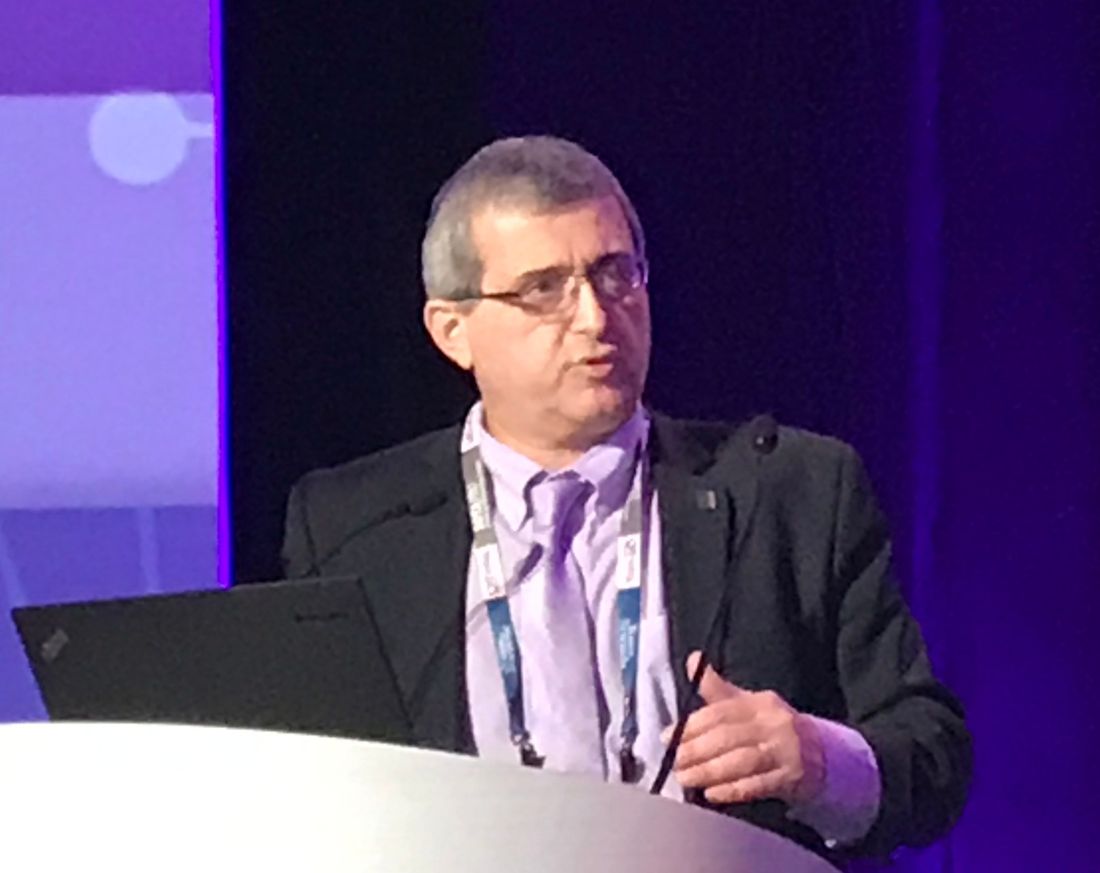User login
Despite failed primary endpoint, MI alert device has predictive value
WASHINGTON –Although an implantable device for detecting myocardial infarction missed the primary composite outcome endpoint in a controlled trial, a newly completed extended analysis associated the device with a higher positive predictive value and a lower false positive rate when compared to sham control, according to data presented at CRT 2019, sponsored by MedStar Heart & Vascular Institute.
“Among high risk patients, this system may be beneficial in the identification of both symptomatic and asymptomatic coronary events,” reported C. Michael Gibson, MD, chief of clinical research in the cardiology division at Beth Israel Deaconess Hospital, Boston.
The implantable device (AngelMed Guardian System), which received Food and Drug Administration approval in April 2018, is designed to identify MI through detection of ST-segment elevations in the absence of an elevated heart rate. When the system detects an event during continuous monitoring, it sends a signal (internal vibration and auditory signal to an external monitor) designed to tell the patient to seek medical care.
The previously published multicenter and randomized ALERTS (AngelMed for Early Recognition and Treatment of STEMI) trial that tested this device was negative for primary composite endpoint of cardiac or unexplained death, new Q-wave MI, or presentation at the emergency department (ED) more than 2 hours after symptom onset (J Am Coll Cardiol. 2019 Feb 25. pii: S0735-1097[19]30237-2). In that trial 907 patients were fitted with the device and then randomized to having the device switched on or left off.
At 7 days, a primary endpoint was reached by 3.8% of those in the device-on group versus 4.9% of those in the device-off group, which was not significantly different.
Although the primary endpoint was not met, there were promising results. For example, in those who did have an occlusive event, patients in the device-on group had better preserved left ventricular function when evaluated after the event, a result consistent with earlier presentation in the ED and earlier treatment. In fact, 85% of patients with an MI in the device-on group presented to a hospital within 2 hours, compared with just 5% of those in the device-off control group during the initial study period.
More evidence of a potential clinical role for the device has now been generated in a new extended analysis. This analysis was made possible because patients in both of the randomized groups continue to wear the device, including those in the device-off group who had their devices activated after 6 months. There are now 3 more years of data of follow-up from those initially in the device-on group and those switched from the device-off group.
“So we started the clock over with a new statistical analysis plan and new endpoints,” Dr. Gibson explained. The FDA was consulted in selecting endpoints, particularly regarding evidence that the device did not increase false-positive ED visits.
There were numerous encouraging findings. One was that 42 silent MIs, which would otherwise have been missed, were detected over the extended follow-up. Another was that the annualized false-positive rate was lower in those with an activated device (0.164/year) when compared to the original device-off group (0.678/year; P less than .001). Lastly, the positive predictive value of an alarm during the extended follow-up was higher than that of symptoms alone among the original device-off group (25.8% vs. 18.2%).
The device was found safe. The rate of system-related complications was under 4%, which Dr. Gibson said is noninferior to that associated with pacemakers.
One of the potential explanations for the failure of the device to achieve the primary endpoint in the original trial was an unexpectedly low event rate, according to Dr. Gibson.
Even before this extended analysis, the FDA had accepted the potential benefits of this device as demonstrated in the approval last year. In the labeling, the device is called “a more accurate predictor of acute coronary syndrome events when compared to patient recognized symptoms alone and demonstrates a reduced rate over time of patient presentations without ACS events.”
“About 50% of patients wait more than 3 hours after the onset of symptoms before reaching an emergency room,” observed Dr. Gibson. Emphasizing the evidence that delay is an important predictor of adverse outcomes, he suggested the alarm device might be useful in accelerating care in some high risk groups.
WASHINGTON –Although an implantable device for detecting myocardial infarction missed the primary composite outcome endpoint in a controlled trial, a newly completed extended analysis associated the device with a higher positive predictive value and a lower false positive rate when compared to sham control, according to data presented at CRT 2019, sponsored by MedStar Heart & Vascular Institute.
“Among high risk patients, this system may be beneficial in the identification of both symptomatic and asymptomatic coronary events,” reported C. Michael Gibson, MD, chief of clinical research in the cardiology division at Beth Israel Deaconess Hospital, Boston.
The implantable device (AngelMed Guardian System), which received Food and Drug Administration approval in April 2018, is designed to identify MI through detection of ST-segment elevations in the absence of an elevated heart rate. When the system detects an event during continuous monitoring, it sends a signal (internal vibration and auditory signal to an external monitor) designed to tell the patient to seek medical care.
The previously published multicenter and randomized ALERTS (AngelMed for Early Recognition and Treatment of STEMI) trial that tested this device was negative for primary composite endpoint of cardiac or unexplained death, new Q-wave MI, or presentation at the emergency department (ED) more than 2 hours after symptom onset (J Am Coll Cardiol. 2019 Feb 25. pii: S0735-1097[19]30237-2). In that trial 907 patients were fitted with the device and then randomized to having the device switched on or left off.
At 7 days, a primary endpoint was reached by 3.8% of those in the device-on group versus 4.9% of those in the device-off group, which was not significantly different.
Although the primary endpoint was not met, there were promising results. For example, in those who did have an occlusive event, patients in the device-on group had better preserved left ventricular function when evaluated after the event, a result consistent with earlier presentation in the ED and earlier treatment. In fact, 85% of patients with an MI in the device-on group presented to a hospital within 2 hours, compared with just 5% of those in the device-off control group during the initial study period.
More evidence of a potential clinical role for the device has now been generated in a new extended analysis. This analysis was made possible because patients in both of the randomized groups continue to wear the device, including those in the device-off group who had their devices activated after 6 months. There are now 3 more years of data of follow-up from those initially in the device-on group and those switched from the device-off group.
“So we started the clock over with a new statistical analysis plan and new endpoints,” Dr. Gibson explained. The FDA was consulted in selecting endpoints, particularly regarding evidence that the device did not increase false-positive ED visits.
There were numerous encouraging findings. One was that 42 silent MIs, which would otherwise have been missed, were detected over the extended follow-up. Another was that the annualized false-positive rate was lower in those with an activated device (0.164/year) when compared to the original device-off group (0.678/year; P less than .001). Lastly, the positive predictive value of an alarm during the extended follow-up was higher than that of symptoms alone among the original device-off group (25.8% vs. 18.2%).
The device was found safe. The rate of system-related complications was under 4%, which Dr. Gibson said is noninferior to that associated with pacemakers.
One of the potential explanations for the failure of the device to achieve the primary endpoint in the original trial was an unexpectedly low event rate, according to Dr. Gibson.
Even before this extended analysis, the FDA had accepted the potential benefits of this device as demonstrated in the approval last year. In the labeling, the device is called “a more accurate predictor of acute coronary syndrome events when compared to patient recognized symptoms alone and demonstrates a reduced rate over time of patient presentations without ACS events.”
“About 50% of patients wait more than 3 hours after the onset of symptoms before reaching an emergency room,” observed Dr. Gibson. Emphasizing the evidence that delay is an important predictor of adverse outcomes, he suggested the alarm device might be useful in accelerating care in some high risk groups.
WASHINGTON –Although an implantable device for detecting myocardial infarction missed the primary composite outcome endpoint in a controlled trial, a newly completed extended analysis associated the device with a higher positive predictive value and a lower false positive rate when compared to sham control, according to data presented at CRT 2019, sponsored by MedStar Heart & Vascular Institute.
“Among high risk patients, this system may be beneficial in the identification of both symptomatic and asymptomatic coronary events,” reported C. Michael Gibson, MD, chief of clinical research in the cardiology division at Beth Israel Deaconess Hospital, Boston.
The implantable device (AngelMed Guardian System), which received Food and Drug Administration approval in April 2018, is designed to identify MI through detection of ST-segment elevations in the absence of an elevated heart rate. When the system detects an event during continuous monitoring, it sends a signal (internal vibration and auditory signal to an external monitor) designed to tell the patient to seek medical care.
The previously published multicenter and randomized ALERTS (AngelMed for Early Recognition and Treatment of STEMI) trial that tested this device was negative for primary composite endpoint of cardiac or unexplained death, new Q-wave MI, or presentation at the emergency department (ED) more than 2 hours after symptom onset (J Am Coll Cardiol. 2019 Feb 25. pii: S0735-1097[19]30237-2). In that trial 907 patients were fitted with the device and then randomized to having the device switched on or left off.
At 7 days, a primary endpoint was reached by 3.8% of those in the device-on group versus 4.9% of those in the device-off group, which was not significantly different.
Although the primary endpoint was not met, there were promising results. For example, in those who did have an occlusive event, patients in the device-on group had better preserved left ventricular function when evaluated after the event, a result consistent with earlier presentation in the ED and earlier treatment. In fact, 85% of patients with an MI in the device-on group presented to a hospital within 2 hours, compared with just 5% of those in the device-off control group during the initial study period.
More evidence of a potential clinical role for the device has now been generated in a new extended analysis. This analysis was made possible because patients in both of the randomized groups continue to wear the device, including those in the device-off group who had their devices activated after 6 months. There are now 3 more years of data of follow-up from those initially in the device-on group and those switched from the device-off group.
“So we started the clock over with a new statistical analysis plan and new endpoints,” Dr. Gibson explained. The FDA was consulted in selecting endpoints, particularly regarding evidence that the device did not increase false-positive ED visits.
There were numerous encouraging findings. One was that 42 silent MIs, which would otherwise have been missed, were detected over the extended follow-up. Another was that the annualized false-positive rate was lower in those with an activated device (0.164/year) when compared to the original device-off group (0.678/year; P less than .001). Lastly, the positive predictive value of an alarm during the extended follow-up was higher than that of symptoms alone among the original device-off group (25.8% vs. 18.2%).
The device was found safe. The rate of system-related complications was under 4%, which Dr. Gibson said is noninferior to that associated with pacemakers.
One of the potential explanations for the failure of the device to achieve the primary endpoint in the original trial was an unexpectedly low event rate, according to Dr. Gibson.
Even before this extended analysis, the FDA had accepted the potential benefits of this device as demonstrated in the approval last year. In the labeling, the device is called “a more accurate predictor of acute coronary syndrome events when compared to patient recognized symptoms alone and demonstrates a reduced rate over time of patient presentations without ACS events.”
“About 50% of patients wait more than 3 hours after the onset of symptoms before reaching an emergency room,” observed Dr. Gibson. Emphasizing the evidence that delay is an important predictor of adverse outcomes, he suggested the alarm device might be useful in accelerating care in some high risk groups.
REPORTING FROM CRT 2019
Adjunctive devices for transcatheter valve replacement improve outcomes
WASHINGTON – One transcatheter device designed to prevent left ventricular outflow tract (LVOT) obstruction relevant to transcatheter mitral valve replacement (TMVR) and another designed to prevent coronary obstruction relevant to transcatheter aortic valve replacement (TAVR) performed well in feasibility studies, according to data presented in two separate late breaking clinical trial sessions at the CRT 2019, sponsored by MedStar Heart & Vascular Institute.
LVOT obstruction prevention
“The 30-day survival in subjects with an increased risk of LVOT obstruction was significantly better than that previously reported in registries,” said Jaffar M. Khan, BM BCh, of the National Heart, Lung, and Blood Institute, who addressing results with the LAMPOON device prior to TMVR,.
LAMPOON is an acronym for intentional Laceration of the Anterior Mitral valve leaflet to Prevent LVOT ObstructioN. Introduced percutaneously and guided to the valve with wires, it was designed to tear existing mitral valve leaflets to prevent them from causing life-threatening LVOT obstruction. It is used immediately prior to TMVR in patients at risk for this complication.
In a feasibility study, delivery, deployment, and retrieval of the device was achieved in all 30 patients. On the basis of the primary endpoint of LVOT gradients of less than 50 mm Hg and no emergency surgery, the procedural success was 73%. The 30-day survival was 93%.
Citing data from registries, Dr. Khan said that the expected survival in TMVR patients with LVOT obstruction caused by a native mitral valve leaflet has been less than 40%. With few existing options to prevent this complication, none of which are reliable, LAMPOON is poised to permit patients who are poor candidates or are contraindicated for TMVR to undergo this treatment, according to Dr. Khan.
“LAMPOON is feasible in all anatomies and calcium patterns,” said Dr. Khan, who noted that gradients of less than 30 mm Hg was achieved in 29 of the 30 patients. Although Dr. Khan acknowledged that this study was small and uncontrolled, and he further cautioned that current strategies for predicting mitral valve leaflet LVOT obstruction are “imprecise,” he believes larger studies of LAMPOON are warranted based on these results.
Coronary artery obstruction prevention
Dr. Khan also presented data on the BASILICA device from a second feasibility study. The device is employed immediately prior to TAVR in order to prevent large aortic valve leaflets, whether native or from an existing bioprosthetic valve, from producing coronary obstruction. BASILICA is an acronym for Bioprosthetic Aortic Scallop Intentional Laceration to prevent Iatrogenic Coronary Artery obstruction.
This device is also introduced percutaneously and uses radiofrequency ablation to split leaflets that are considered to pose a risk for coronary obstruction. Even though Dr. Khan acknowledged that there is also a lack of precision for predicting which TAVR candidates require an intervention to prevent coronary obstruction, he cited mortality rates exceeding 40% when this complication occurs.
In the feasibility study, 30 patients, of whom 80% were female, were enrolled. In half of the cases, the target for BASILICA was a native valve. The remainder was treated for risk of coronary obstruction posed by a bioprosthetic valve. Multiple comorbidities, including a high proportion with prior stroke, made those selected for enrollment poor candidates for surgery.
The BASILICA intervention was successful in 28 of the 30 participants and in 35 of the 37 leaflets treated. At 30 days, there was one death and one disabling stroke. The overall success rate of the procedure was 93%, according to Dr. Khan.
“One hundred percent of patients were discharged from the cath lab without coronary obstruction despite the high baseline risk,” Dr. Khan said. Again, larger studies are needed to validate the safety and efficacy of this approach, but Dr. Khan believes the outcomes in this study warrant expanded clinical studies.
WASHINGTON – One transcatheter device designed to prevent left ventricular outflow tract (LVOT) obstruction relevant to transcatheter mitral valve replacement (TMVR) and another designed to prevent coronary obstruction relevant to transcatheter aortic valve replacement (TAVR) performed well in feasibility studies, according to data presented in two separate late breaking clinical trial sessions at the CRT 2019, sponsored by MedStar Heart & Vascular Institute.
LVOT obstruction prevention
“The 30-day survival in subjects with an increased risk of LVOT obstruction was significantly better than that previously reported in registries,” said Jaffar M. Khan, BM BCh, of the National Heart, Lung, and Blood Institute, who addressing results with the LAMPOON device prior to TMVR,.
LAMPOON is an acronym for intentional Laceration of the Anterior Mitral valve leaflet to Prevent LVOT ObstructioN. Introduced percutaneously and guided to the valve with wires, it was designed to tear existing mitral valve leaflets to prevent them from causing life-threatening LVOT obstruction. It is used immediately prior to TMVR in patients at risk for this complication.
In a feasibility study, delivery, deployment, and retrieval of the device was achieved in all 30 patients. On the basis of the primary endpoint of LVOT gradients of less than 50 mm Hg and no emergency surgery, the procedural success was 73%. The 30-day survival was 93%.
Citing data from registries, Dr. Khan said that the expected survival in TMVR patients with LVOT obstruction caused by a native mitral valve leaflet has been less than 40%. With few existing options to prevent this complication, none of which are reliable, LAMPOON is poised to permit patients who are poor candidates or are contraindicated for TMVR to undergo this treatment, according to Dr. Khan.
“LAMPOON is feasible in all anatomies and calcium patterns,” said Dr. Khan, who noted that gradients of less than 30 mm Hg was achieved in 29 of the 30 patients. Although Dr. Khan acknowledged that this study was small and uncontrolled, and he further cautioned that current strategies for predicting mitral valve leaflet LVOT obstruction are “imprecise,” he believes larger studies of LAMPOON are warranted based on these results.
Coronary artery obstruction prevention
Dr. Khan also presented data on the BASILICA device from a second feasibility study. The device is employed immediately prior to TAVR in order to prevent large aortic valve leaflets, whether native or from an existing bioprosthetic valve, from producing coronary obstruction. BASILICA is an acronym for Bioprosthetic Aortic Scallop Intentional Laceration to prevent Iatrogenic Coronary Artery obstruction.
This device is also introduced percutaneously and uses radiofrequency ablation to split leaflets that are considered to pose a risk for coronary obstruction. Even though Dr. Khan acknowledged that there is also a lack of precision for predicting which TAVR candidates require an intervention to prevent coronary obstruction, he cited mortality rates exceeding 40% when this complication occurs.
In the feasibility study, 30 patients, of whom 80% were female, were enrolled. In half of the cases, the target for BASILICA was a native valve. The remainder was treated for risk of coronary obstruction posed by a bioprosthetic valve. Multiple comorbidities, including a high proportion with prior stroke, made those selected for enrollment poor candidates for surgery.
The BASILICA intervention was successful in 28 of the 30 participants and in 35 of the 37 leaflets treated. At 30 days, there was one death and one disabling stroke. The overall success rate of the procedure was 93%, according to Dr. Khan.
“One hundred percent of patients were discharged from the cath lab without coronary obstruction despite the high baseline risk,” Dr. Khan said. Again, larger studies are needed to validate the safety and efficacy of this approach, but Dr. Khan believes the outcomes in this study warrant expanded clinical studies.
WASHINGTON – One transcatheter device designed to prevent left ventricular outflow tract (LVOT) obstruction relevant to transcatheter mitral valve replacement (TMVR) and another designed to prevent coronary obstruction relevant to transcatheter aortic valve replacement (TAVR) performed well in feasibility studies, according to data presented in two separate late breaking clinical trial sessions at the CRT 2019, sponsored by MedStar Heart & Vascular Institute.
LVOT obstruction prevention
“The 30-day survival in subjects with an increased risk of LVOT obstruction was significantly better than that previously reported in registries,” said Jaffar M. Khan, BM BCh, of the National Heart, Lung, and Blood Institute, who addressing results with the LAMPOON device prior to TMVR,.
LAMPOON is an acronym for intentional Laceration of the Anterior Mitral valve leaflet to Prevent LVOT ObstructioN. Introduced percutaneously and guided to the valve with wires, it was designed to tear existing mitral valve leaflets to prevent them from causing life-threatening LVOT obstruction. It is used immediately prior to TMVR in patients at risk for this complication.
In a feasibility study, delivery, deployment, and retrieval of the device was achieved in all 30 patients. On the basis of the primary endpoint of LVOT gradients of less than 50 mm Hg and no emergency surgery, the procedural success was 73%. The 30-day survival was 93%.
Citing data from registries, Dr. Khan said that the expected survival in TMVR patients with LVOT obstruction caused by a native mitral valve leaflet has been less than 40%. With few existing options to prevent this complication, none of which are reliable, LAMPOON is poised to permit patients who are poor candidates or are contraindicated for TMVR to undergo this treatment, according to Dr. Khan.
“LAMPOON is feasible in all anatomies and calcium patterns,” said Dr. Khan, who noted that gradients of less than 30 mm Hg was achieved in 29 of the 30 patients. Although Dr. Khan acknowledged that this study was small and uncontrolled, and he further cautioned that current strategies for predicting mitral valve leaflet LVOT obstruction are “imprecise,” he believes larger studies of LAMPOON are warranted based on these results.
Coronary artery obstruction prevention
Dr. Khan also presented data on the BASILICA device from a second feasibility study. The device is employed immediately prior to TAVR in order to prevent large aortic valve leaflets, whether native or from an existing bioprosthetic valve, from producing coronary obstruction. BASILICA is an acronym for Bioprosthetic Aortic Scallop Intentional Laceration to prevent Iatrogenic Coronary Artery obstruction.
This device is also introduced percutaneously and uses radiofrequency ablation to split leaflets that are considered to pose a risk for coronary obstruction. Even though Dr. Khan acknowledged that there is also a lack of precision for predicting which TAVR candidates require an intervention to prevent coronary obstruction, he cited mortality rates exceeding 40% when this complication occurs.
In the feasibility study, 30 patients, of whom 80% were female, were enrolled. In half of the cases, the target for BASILICA was a native valve. The remainder was treated for risk of coronary obstruction posed by a bioprosthetic valve. Multiple comorbidities, including a high proportion with prior stroke, made those selected for enrollment poor candidates for surgery.
The BASILICA intervention was successful in 28 of the 30 participants and in 35 of the 37 leaflets treated. At 30 days, there was one death and one disabling stroke. The overall success rate of the procedure was 93%, according to Dr. Khan.
“One hundred percent of patients were discharged from the cath lab without coronary obstruction despite the high baseline risk,” Dr. Khan said. Again, larger studies are needed to validate the safety and efficacy of this approach, but Dr. Khan believes the outcomes in this study warrant expanded clinical studies.
REPORTING FROM CRT 2019
No further amplification of signal for benefit from ultrathin stent at 3 years
WASHINGTON – In the latest analysis of data from a randomized trial comparing three different thin polymer-coated drug-eluting stents, the signal at 1 year that the thinnest device might reduce risk of target lesion revascularization has been lost at 3 years, according to an update of results from the BIO-RESORT trial presented at CRT 2019 sponsored by MedStar Heart & Vascular Institute.
“At 3-year follow-up, all three drug-eluting stents were associated with favorable outcomes and both very thin strut polymer-coated devices showed safety and patency similar to the thin-strut durable polymer drug-eluting stent,” reported Clemons von Birgelen, MD, PhD, professor of cardiology, University of Twente, Enschede, the Netherlands.
In order of strut thickness, the stents tested in BIO-RESORT were Orsiro (60 mcm), Synergy (74 mcm), and Resolute Integrity (90 mcm). Although the study had a noninferiority design, the potential for the biodegradable polymer coatings of the two thinner stents to provide faster healing than the durable polymer of the Resolute stent was one of the driving hypotheses of the trial (Lancet. 2016 Nov 26;388[10060]:2607-17).
Some support for this hypothesis was provided by 2-year results presented at EuroPCR 2018 last year. At that time, it was reported that the risk of target lesion revascularization between the end of year 1 and end of year 2 was significantly lower for the Orsiro stent (1.3%) than the Resolute stent (2.3%). Target lesion revascularization also was lower in the Synergy stent group (1.8%), but this rate did not differ significantly from that of the other two stents in the trial.
Now, reassessed at 3 years, the target lesion revascularization rates are 2.9%, 3.3%, and 3.8% for the Orsiro, Synergy, and Resolute stents, respectively. Although the numerical hierarchy is preserved, the differences are no longer significant.
Other outcomes, including the primary outcome of target lesion failure, show the same numerical hierarchy but, again, without differences reaching significance. For target lesion failure, these rates are 8.5%, 8.8%, and 10.0%, respectively.
The difference in the rates of stent thrombosis at 3 years was even smaller with rates of less than 1% for all three stents. A catch-up phenomenon between years 2 and 3 of follow-up largely eliminated a numerical advantage seen earlier for the Orsiro stent.
The BIO-RESORT trial randomized 3,514 patients, of whom 70% had an acute coronary syndrome. Nearly one-third had an ST-elevated myocardial infarction. Dr. von Birgelen emphasized that this was “a very complex study population.” For example, roughly 20% had severely calcified lesions. Follow-up data were available on 97% of the randomized patients at 3 years.
There are differences between these stents other than thickness and the durability of the polymer. In particular, Orsiro is coated with sirolimus, Synergy with everolimus, and Resolute with zotarolimus. While the metals of the frame also differ, the estimated time to resorption of the polymer is faster with the Synergy stent (4 months) than the Orsiro stent (24 months).
Despite the loss of a difference in target vessel revascularization in the most recent follow-up, the potential for the differences in designs and materials to influence risk of late complications, including revascularization and thrombosis, persists.
“Follow-up beyond 3 years is of interest to definitely answer the question of whether one of these drug-eluting stents might improve outcome at a later stage,” Dr. von Birgelen said.
WASHINGTON – In the latest analysis of data from a randomized trial comparing three different thin polymer-coated drug-eluting stents, the signal at 1 year that the thinnest device might reduce risk of target lesion revascularization has been lost at 3 years, according to an update of results from the BIO-RESORT trial presented at CRT 2019 sponsored by MedStar Heart & Vascular Institute.
“At 3-year follow-up, all three drug-eluting stents were associated with favorable outcomes and both very thin strut polymer-coated devices showed safety and patency similar to the thin-strut durable polymer drug-eluting stent,” reported Clemons von Birgelen, MD, PhD, professor of cardiology, University of Twente, Enschede, the Netherlands.
In order of strut thickness, the stents tested in BIO-RESORT were Orsiro (60 mcm), Synergy (74 mcm), and Resolute Integrity (90 mcm). Although the study had a noninferiority design, the potential for the biodegradable polymer coatings of the two thinner stents to provide faster healing than the durable polymer of the Resolute stent was one of the driving hypotheses of the trial (Lancet. 2016 Nov 26;388[10060]:2607-17).
Some support for this hypothesis was provided by 2-year results presented at EuroPCR 2018 last year. At that time, it was reported that the risk of target lesion revascularization between the end of year 1 and end of year 2 was significantly lower for the Orsiro stent (1.3%) than the Resolute stent (2.3%). Target lesion revascularization also was lower in the Synergy stent group (1.8%), but this rate did not differ significantly from that of the other two stents in the trial.
Now, reassessed at 3 years, the target lesion revascularization rates are 2.9%, 3.3%, and 3.8% for the Orsiro, Synergy, and Resolute stents, respectively. Although the numerical hierarchy is preserved, the differences are no longer significant.
Other outcomes, including the primary outcome of target lesion failure, show the same numerical hierarchy but, again, without differences reaching significance. For target lesion failure, these rates are 8.5%, 8.8%, and 10.0%, respectively.
The difference in the rates of stent thrombosis at 3 years was even smaller with rates of less than 1% for all three stents. A catch-up phenomenon between years 2 and 3 of follow-up largely eliminated a numerical advantage seen earlier for the Orsiro stent.
The BIO-RESORT trial randomized 3,514 patients, of whom 70% had an acute coronary syndrome. Nearly one-third had an ST-elevated myocardial infarction. Dr. von Birgelen emphasized that this was “a very complex study population.” For example, roughly 20% had severely calcified lesions. Follow-up data were available on 97% of the randomized patients at 3 years.
There are differences between these stents other than thickness and the durability of the polymer. In particular, Orsiro is coated with sirolimus, Synergy with everolimus, and Resolute with zotarolimus. While the metals of the frame also differ, the estimated time to resorption of the polymer is faster with the Synergy stent (4 months) than the Orsiro stent (24 months).
Despite the loss of a difference in target vessel revascularization in the most recent follow-up, the potential for the differences in designs and materials to influence risk of late complications, including revascularization and thrombosis, persists.
“Follow-up beyond 3 years is of interest to definitely answer the question of whether one of these drug-eluting stents might improve outcome at a later stage,” Dr. von Birgelen said.
WASHINGTON – In the latest analysis of data from a randomized trial comparing three different thin polymer-coated drug-eluting stents, the signal at 1 year that the thinnest device might reduce risk of target lesion revascularization has been lost at 3 years, according to an update of results from the BIO-RESORT trial presented at CRT 2019 sponsored by MedStar Heart & Vascular Institute.
“At 3-year follow-up, all three drug-eluting stents were associated with favorable outcomes and both very thin strut polymer-coated devices showed safety and patency similar to the thin-strut durable polymer drug-eluting stent,” reported Clemons von Birgelen, MD, PhD, professor of cardiology, University of Twente, Enschede, the Netherlands.
In order of strut thickness, the stents tested in BIO-RESORT were Orsiro (60 mcm), Synergy (74 mcm), and Resolute Integrity (90 mcm). Although the study had a noninferiority design, the potential for the biodegradable polymer coatings of the two thinner stents to provide faster healing than the durable polymer of the Resolute stent was one of the driving hypotheses of the trial (Lancet. 2016 Nov 26;388[10060]:2607-17).
Some support for this hypothesis was provided by 2-year results presented at EuroPCR 2018 last year. At that time, it was reported that the risk of target lesion revascularization between the end of year 1 and end of year 2 was significantly lower for the Orsiro stent (1.3%) than the Resolute stent (2.3%). Target lesion revascularization also was lower in the Synergy stent group (1.8%), but this rate did not differ significantly from that of the other two stents in the trial.
Now, reassessed at 3 years, the target lesion revascularization rates are 2.9%, 3.3%, and 3.8% for the Orsiro, Synergy, and Resolute stents, respectively. Although the numerical hierarchy is preserved, the differences are no longer significant.
Other outcomes, including the primary outcome of target lesion failure, show the same numerical hierarchy but, again, without differences reaching significance. For target lesion failure, these rates are 8.5%, 8.8%, and 10.0%, respectively.
The difference in the rates of stent thrombosis at 3 years was even smaller with rates of less than 1% for all three stents. A catch-up phenomenon between years 2 and 3 of follow-up largely eliminated a numerical advantage seen earlier for the Orsiro stent.
The BIO-RESORT trial randomized 3,514 patients, of whom 70% had an acute coronary syndrome. Nearly one-third had an ST-elevated myocardial infarction. Dr. von Birgelen emphasized that this was “a very complex study population.” For example, roughly 20% had severely calcified lesions. Follow-up data were available on 97% of the randomized patients at 3 years.
There are differences between these stents other than thickness and the durability of the polymer. In particular, Orsiro is coated with sirolimus, Synergy with everolimus, and Resolute with zotarolimus. While the metals of the frame also differ, the estimated time to resorption of the polymer is faster with the Synergy stent (4 months) than the Orsiro stent (24 months).
Despite the loss of a difference in target vessel revascularization in the most recent follow-up, the potential for the differences in designs and materials to influence risk of late complications, including revascularization and thrombosis, persists.
“Follow-up beyond 3 years is of interest to definitely answer the question of whether one of these drug-eluting stents might improve outcome at a later stage,” Dr. von Birgelen said.
REPORTING FROM CRT 2019
30-day readmissions after STEMI with cardiogenic shock 13%
WASHINGTON – and remain in hospital for an average of 6 days, according to an analysis from the National Readmission Database presented at CRT 2019 sponsored by MedStar Heart & Vascular Institute.
“About one in four of the readmissions was for heart failure,” reported Karan Sud, MD, a cardiology resident at the Mount Sinai St. Luke’s West Hospital, New York.
Despite gains in acute survival among STEMI patients in cardiogenic shock, little attention has been paid to the risk of readmissions, according to Dr. Sud. According to data collected from the National Readmissions Database for 2010-2014, these rates are high enough to deserve attention, he said.
“Our goal is now to develop a scoring system based on our predictive model to identify patients at the index admission who are at risk for readmission,” Dr. Sud reported. On the basis of these predictors, it might be possible to implement strategies to optimize management and improve access to care.
In the years studied, there were 94,991 patients with STEMI and cardiogenic shock captured in the National Readmissions Database, of whom 43,205 survived and were followed for readmission. Of the 5,503 readmissions within 30 days, 12% were considered unplanned.
Half of the readmissions were for noncardiovascular causes, including sepsis, respiratory failure, and major bleeding. Of those related to cardiovascular disease, about half, or nearly 25% of the total, were for heart failure.
The predictors of readmission included female sex, age older than 75 years, average length of stay longer than 10 days, and more than three comorbidities, such as diabetes or chronic kidney disease, according to Dr. Sud.
“Those sent home from the index admission were more likely than those discharged to an extended care facility to be readmitted,” he added. He also noted that lower socioeconomic status was a risk factor for readmission, a phenomenon that he attributed to access issues regarding follow-up care.
“We are now conducting a prospective study to look at readmissions at 6 months,” reported Dr. Sud, who believes that efforts to understand the risk of readmission following STEMI complicated by cardiogenic shock might uncover opportunities for better management.
WASHINGTON – and remain in hospital for an average of 6 days, according to an analysis from the National Readmission Database presented at CRT 2019 sponsored by MedStar Heart & Vascular Institute.
“About one in four of the readmissions was for heart failure,” reported Karan Sud, MD, a cardiology resident at the Mount Sinai St. Luke’s West Hospital, New York.
Despite gains in acute survival among STEMI patients in cardiogenic shock, little attention has been paid to the risk of readmissions, according to Dr. Sud. According to data collected from the National Readmissions Database for 2010-2014, these rates are high enough to deserve attention, he said.
“Our goal is now to develop a scoring system based on our predictive model to identify patients at the index admission who are at risk for readmission,” Dr. Sud reported. On the basis of these predictors, it might be possible to implement strategies to optimize management and improve access to care.
In the years studied, there were 94,991 patients with STEMI and cardiogenic shock captured in the National Readmissions Database, of whom 43,205 survived and were followed for readmission. Of the 5,503 readmissions within 30 days, 12% were considered unplanned.
Half of the readmissions were for noncardiovascular causes, including sepsis, respiratory failure, and major bleeding. Of those related to cardiovascular disease, about half, or nearly 25% of the total, were for heart failure.
The predictors of readmission included female sex, age older than 75 years, average length of stay longer than 10 days, and more than three comorbidities, such as diabetes or chronic kidney disease, according to Dr. Sud.
“Those sent home from the index admission were more likely than those discharged to an extended care facility to be readmitted,” he added. He also noted that lower socioeconomic status was a risk factor for readmission, a phenomenon that he attributed to access issues regarding follow-up care.
“We are now conducting a prospective study to look at readmissions at 6 months,” reported Dr. Sud, who believes that efforts to understand the risk of readmission following STEMI complicated by cardiogenic shock might uncover opportunities for better management.
WASHINGTON – and remain in hospital for an average of 6 days, according to an analysis from the National Readmission Database presented at CRT 2019 sponsored by MedStar Heart & Vascular Institute.
“About one in four of the readmissions was for heart failure,” reported Karan Sud, MD, a cardiology resident at the Mount Sinai St. Luke’s West Hospital, New York.
Despite gains in acute survival among STEMI patients in cardiogenic shock, little attention has been paid to the risk of readmissions, according to Dr. Sud. According to data collected from the National Readmissions Database for 2010-2014, these rates are high enough to deserve attention, he said.
“Our goal is now to develop a scoring system based on our predictive model to identify patients at the index admission who are at risk for readmission,” Dr. Sud reported. On the basis of these predictors, it might be possible to implement strategies to optimize management and improve access to care.
In the years studied, there were 94,991 patients with STEMI and cardiogenic shock captured in the National Readmissions Database, of whom 43,205 survived and were followed for readmission. Of the 5,503 readmissions within 30 days, 12% were considered unplanned.
Half of the readmissions were for noncardiovascular causes, including sepsis, respiratory failure, and major bleeding. Of those related to cardiovascular disease, about half, or nearly 25% of the total, were for heart failure.
The predictors of readmission included female sex, age older than 75 years, average length of stay longer than 10 days, and more than three comorbidities, such as diabetes or chronic kidney disease, according to Dr. Sud.
“Those sent home from the index admission were more likely than those discharged to an extended care facility to be readmitted,” he added. He also noted that lower socioeconomic status was a risk factor for readmission, a phenomenon that he attributed to access issues regarding follow-up care.
“We are now conducting a prospective study to look at readmissions at 6 months,” reported Dr. Sud, who believes that efforts to understand the risk of readmission following STEMI complicated by cardiogenic shock might uncover opportunities for better management.
REPORTING FROM CRT 2019
Real-world efficacy with intravascular lithotripsy
washington, dc – A real-world case series suggests intravascular lithotripsy (IVL) is safe and effective when used selectively to treat coronary arterial calcifications, according to data presented at the 2019 Transcatheter Cardiovascular Therapeutics (CRT) meeting.
Relative to other options, “IVL offers a more controlled means of calcium modification and it avoids the no-reflow phenomenon common to atherectomy in patients with a high calcium burden,” reported Julian Yeoh, MBBS, an interventional cardiologist affiliated with King’s College Hospital, London, UK.
On the basis of the DISRUPT CAD study, presented at the 2016 TCT meeting, IVL was approved in Europe for calcified coronary artery disease in May 2018. The Shockwave IVL device (Shockwave Medical) is currently approved in the U.S. only for treatment of calcified lesions associated with peripheral artery disease (PAD).
In what was characterized as a “real-world series,” 14 procedures were performed at Dr. Yeoh’s institution as part of a clinical study, but 40 procedures were completed on an all-comer basis. Many were performed for indications, such as multivessel disease, that would have been excluded from the DISRUPT CAD study.
“We included elderly patients, patients in cardiogenic shock, and patients with chronic total occlusions,” Dr. Yeoh reported. Presenting specific cases, he described using IVL to permit venous access for a transcatheter aortic valve replacement (TAVR), a failed rotational atherectomy, and to salvage a percutaneous angioplasty thwarted by residual calcium calcification.
“Total procedural success in this series was 91% with 100% facilitation of stent delivery,” Dr. Yeoh said. “There have been no cases of coronary perforation and no reflow or 30-day target lesion failure.”
In this series, the mean age of the patients was 75.9 years. On optical coherence tomography (OCT), which was employed in about half of the cases, the mean residual stenosis was approximately 20%.
IVL involves passing a balloon into the target lesion with the same guidewire used for other percutaneous interventions. Once in position, sonic pressure waves fracture the calcium deposit “with no injury to the intimal soft tissue,” according to Dr. Yeoh, who said that there were no serious adverse events associated with IVL in the series he presented.
In DISRUPT CAD, which enrolled 60 patients, procedural success was 95% with a reduction in mean stenosis from 68.1% to 13.1%. The rate of major adverse cardiovascular event (MACE) events was 5% at 30 days.
While DISRUPT CAD-II is an on-going post-market registry collecting data in Europe and other areas of the world where IVL is approved for treatment of coronary artery disease, a pivotal trial called DISRUPT CAD III has been launched to gain an indication for treatment of coronary calcifications in the U.S. The prospective global trial has a planned enrollment of nearly 400 patients with expected completion in August 2020.
SOURCE: Yeoh J et al. 2019 Cardiovascular Research Technologies (CRT) Meeting abstract.
washington, dc – A real-world case series suggests intravascular lithotripsy (IVL) is safe and effective when used selectively to treat coronary arterial calcifications, according to data presented at the 2019 Transcatheter Cardiovascular Therapeutics (CRT) meeting.
Relative to other options, “IVL offers a more controlled means of calcium modification and it avoids the no-reflow phenomenon common to atherectomy in patients with a high calcium burden,” reported Julian Yeoh, MBBS, an interventional cardiologist affiliated with King’s College Hospital, London, UK.
On the basis of the DISRUPT CAD study, presented at the 2016 TCT meeting, IVL was approved in Europe for calcified coronary artery disease in May 2018. The Shockwave IVL device (Shockwave Medical) is currently approved in the U.S. only for treatment of calcified lesions associated with peripheral artery disease (PAD).
In what was characterized as a “real-world series,” 14 procedures were performed at Dr. Yeoh’s institution as part of a clinical study, but 40 procedures were completed on an all-comer basis. Many were performed for indications, such as multivessel disease, that would have been excluded from the DISRUPT CAD study.
“We included elderly patients, patients in cardiogenic shock, and patients with chronic total occlusions,” Dr. Yeoh reported. Presenting specific cases, he described using IVL to permit venous access for a transcatheter aortic valve replacement (TAVR), a failed rotational atherectomy, and to salvage a percutaneous angioplasty thwarted by residual calcium calcification.
“Total procedural success in this series was 91% with 100% facilitation of stent delivery,” Dr. Yeoh said. “There have been no cases of coronary perforation and no reflow or 30-day target lesion failure.”
In this series, the mean age of the patients was 75.9 years. On optical coherence tomography (OCT), which was employed in about half of the cases, the mean residual stenosis was approximately 20%.
IVL involves passing a balloon into the target lesion with the same guidewire used for other percutaneous interventions. Once in position, sonic pressure waves fracture the calcium deposit “with no injury to the intimal soft tissue,” according to Dr. Yeoh, who said that there were no serious adverse events associated with IVL in the series he presented.
In DISRUPT CAD, which enrolled 60 patients, procedural success was 95% with a reduction in mean stenosis from 68.1% to 13.1%. The rate of major adverse cardiovascular event (MACE) events was 5% at 30 days.
While DISRUPT CAD-II is an on-going post-market registry collecting data in Europe and other areas of the world where IVL is approved for treatment of coronary artery disease, a pivotal trial called DISRUPT CAD III has been launched to gain an indication for treatment of coronary calcifications in the U.S. The prospective global trial has a planned enrollment of nearly 400 patients with expected completion in August 2020.
SOURCE: Yeoh J et al. 2019 Cardiovascular Research Technologies (CRT) Meeting abstract.
washington, dc – A real-world case series suggests intravascular lithotripsy (IVL) is safe and effective when used selectively to treat coronary arterial calcifications, according to data presented at the 2019 Transcatheter Cardiovascular Therapeutics (CRT) meeting.
Relative to other options, “IVL offers a more controlled means of calcium modification and it avoids the no-reflow phenomenon common to atherectomy in patients with a high calcium burden,” reported Julian Yeoh, MBBS, an interventional cardiologist affiliated with King’s College Hospital, London, UK.
On the basis of the DISRUPT CAD study, presented at the 2016 TCT meeting, IVL was approved in Europe for calcified coronary artery disease in May 2018. The Shockwave IVL device (Shockwave Medical) is currently approved in the U.S. only for treatment of calcified lesions associated with peripheral artery disease (PAD).
In what was characterized as a “real-world series,” 14 procedures were performed at Dr. Yeoh’s institution as part of a clinical study, but 40 procedures were completed on an all-comer basis. Many were performed for indications, such as multivessel disease, that would have been excluded from the DISRUPT CAD study.
“We included elderly patients, patients in cardiogenic shock, and patients with chronic total occlusions,” Dr. Yeoh reported. Presenting specific cases, he described using IVL to permit venous access for a transcatheter aortic valve replacement (TAVR), a failed rotational atherectomy, and to salvage a percutaneous angioplasty thwarted by residual calcium calcification.
“Total procedural success in this series was 91% with 100% facilitation of stent delivery,” Dr. Yeoh said. “There have been no cases of coronary perforation and no reflow or 30-day target lesion failure.”
In this series, the mean age of the patients was 75.9 years. On optical coherence tomography (OCT), which was employed in about half of the cases, the mean residual stenosis was approximately 20%.
IVL involves passing a balloon into the target lesion with the same guidewire used for other percutaneous interventions. Once in position, sonic pressure waves fracture the calcium deposit “with no injury to the intimal soft tissue,” according to Dr. Yeoh, who said that there were no serious adverse events associated with IVL in the series he presented.
In DISRUPT CAD, which enrolled 60 patients, procedural success was 95% with a reduction in mean stenosis from 68.1% to 13.1%. The rate of major adverse cardiovascular event (MACE) events was 5% at 30 days.
While DISRUPT CAD-II is an on-going post-market registry collecting data in Europe and other areas of the world where IVL is approved for treatment of coronary artery disease, a pivotal trial called DISRUPT CAD III has been launched to gain an indication for treatment of coronary calcifications in the U.S. The prospective global trial has a planned enrollment of nearly 400 patients with expected completion in August 2020.
SOURCE: Yeoh J et al. 2019 Cardiovascular Research Technologies (CRT) Meeting abstract.
REPORTING FROM CRT 2019
Endovascular device sustains blood pressure control after 3 years
WASHINGTON – As a result of remarkably sustained antihypertensive effect, interest is intensifying in the potential for a pivotal trial to associate a novel endovascular device with unprecedented blood pressure control in patients with treatment-resistant hypertension, according to an update presented at CRT 2019, sponsored by MedStar Heart & Vascular Institute.
With up to 3 years of follow-up, “systolic blood pressures have remained persistently reduced by as much as 24 mm Hg,” reported John P. Reilly, MD, an interventional cardiologist in Southampton, N.Y., who presented follow-up data for some of those enrolled in the first-in-human study of this device.
When the stent-like device is placed in the carotid artery, it alters its geometric shape, which increases pulsatile wall strain. The increase on wall strain alters an afferent signaling loop controlled by carotid baroreceptors that inhibits sympathetic outflow to lower blood pressure.
In the proof-of-principle, first-in-human CALM study, 47 patients were implanted with the device (MobiusHD, Vascular Dynamics). The initial study enrolled 30 subjects in Europe and 17 in the United States. Initial findings in the cohort of European patients, which included a mean 21–mm Hg reduction in systolic blood pressure and a 12–mm Hg reduction in diastolic blood pressure measured by ambulatory monitoring at 6 months, were published in the Lancet (2017 Dec 16;390[10113]:2655-661).
The patients enrolled in the proof-of-principle CALM trial were required to have highly-treatment-resistant hypertension, defined as a systolic blood pressure greater than or equal to 160 mm Hg despite at least three antihypertensive medications. The average number of medications was 4.4, according to Dr. Reilly. The mean blood pressure at entry was 165/98 mm Hg. Nearly 20% had previously undergone renal denervation.
The device was successfully deployed in all of the patients who participated in the open-label CALM study. Most of the 10 serious adverse events were related to hypotension, according to Dr. Reilly. Others included a wound infection and a case of intermittent claudication. Two instances of neurologic complaints, such as numbness and weakness, experienced within a day of device placement were considered potential transient ischemic attacks, but these resolved completely and no defects were observed on imaging.
In an update on CALM, Dr. Reilly reported that the large reductions in blood pressure previously reported at 6 months have been sustained. Follow-up is approximately 3 years in most patients, and the reductions previously reported have persisted in responders. When a clinically significant response is defined as a 10–mm Hg or more reduction in office blood pressure or 5–mm Hg or more reduction in ambulatory blood pressure, 75% of patients enrolled are still responding, but the more important point is that there has been no substantial reduction in blood pressure control over time in responders, according to Dr. Reilly.
When patients were stratified by a pulse pressure of greater or less than 70 mm Hg at study entry, response rates have been similar, he added.
The long-term responses are significant because there was concern about tachyphylaxis. In fact, coronary stents also produce a reduction in blood pressure immediately after placement that is likely caused by the same effect, but that effect “peters out in a day or 2,” noted Dr. Reilly. As opposed to the round shape of coronary stents, the rectangular shape of the novel device produces “an increase in the perceived strain on the carotid body” that does not appear to diminish over time.
CALM-2, which is designed to be a pivotal trial to support regulatory approval of the device, began enrolling in September 2018. An enrollment of 300 patients with treatment-resistant hypertension is planned. Participants will be randomized to receive the device or a sham procedure consisting of a carotid artery angiogram, according to Dr. Reilly. Although the initial CALM trial was small, open label, and conducted without a control, the persistent benefit over extended follow-up is driving excitement about the potential of this device.
“These are some of the greatest sustained reductions in ambulatory blood pressure we have ever seen,” according to Vasilios Papademetriou, MD, PhD, a professor of medicine at Georgetown University, Washington. Impressed by undiminished blood pressure control observed so far, he characterized the promise of this device as “very compelling.”
Dr. Reilly disclosed that he was a stockholder in Johnson & Johnson.
WASHINGTON – As a result of remarkably sustained antihypertensive effect, interest is intensifying in the potential for a pivotal trial to associate a novel endovascular device with unprecedented blood pressure control in patients with treatment-resistant hypertension, according to an update presented at CRT 2019, sponsored by MedStar Heart & Vascular Institute.
With up to 3 years of follow-up, “systolic blood pressures have remained persistently reduced by as much as 24 mm Hg,” reported John P. Reilly, MD, an interventional cardiologist in Southampton, N.Y., who presented follow-up data for some of those enrolled in the first-in-human study of this device.
When the stent-like device is placed in the carotid artery, it alters its geometric shape, which increases pulsatile wall strain. The increase on wall strain alters an afferent signaling loop controlled by carotid baroreceptors that inhibits sympathetic outflow to lower blood pressure.
In the proof-of-principle, first-in-human CALM study, 47 patients were implanted with the device (MobiusHD, Vascular Dynamics). The initial study enrolled 30 subjects in Europe and 17 in the United States. Initial findings in the cohort of European patients, which included a mean 21–mm Hg reduction in systolic blood pressure and a 12–mm Hg reduction in diastolic blood pressure measured by ambulatory monitoring at 6 months, were published in the Lancet (2017 Dec 16;390[10113]:2655-661).
The patients enrolled in the proof-of-principle CALM trial were required to have highly-treatment-resistant hypertension, defined as a systolic blood pressure greater than or equal to 160 mm Hg despite at least three antihypertensive medications. The average number of medications was 4.4, according to Dr. Reilly. The mean blood pressure at entry was 165/98 mm Hg. Nearly 20% had previously undergone renal denervation.
The device was successfully deployed in all of the patients who participated in the open-label CALM study. Most of the 10 serious adverse events were related to hypotension, according to Dr. Reilly. Others included a wound infection and a case of intermittent claudication. Two instances of neurologic complaints, such as numbness and weakness, experienced within a day of device placement were considered potential transient ischemic attacks, but these resolved completely and no defects were observed on imaging.
In an update on CALM, Dr. Reilly reported that the large reductions in blood pressure previously reported at 6 months have been sustained. Follow-up is approximately 3 years in most patients, and the reductions previously reported have persisted in responders. When a clinically significant response is defined as a 10–mm Hg or more reduction in office blood pressure or 5–mm Hg or more reduction in ambulatory blood pressure, 75% of patients enrolled are still responding, but the more important point is that there has been no substantial reduction in blood pressure control over time in responders, according to Dr. Reilly.
When patients were stratified by a pulse pressure of greater or less than 70 mm Hg at study entry, response rates have been similar, he added.
The long-term responses are significant because there was concern about tachyphylaxis. In fact, coronary stents also produce a reduction in blood pressure immediately after placement that is likely caused by the same effect, but that effect “peters out in a day or 2,” noted Dr. Reilly. As opposed to the round shape of coronary stents, the rectangular shape of the novel device produces “an increase in the perceived strain on the carotid body” that does not appear to diminish over time.
CALM-2, which is designed to be a pivotal trial to support regulatory approval of the device, began enrolling in September 2018. An enrollment of 300 patients with treatment-resistant hypertension is planned. Participants will be randomized to receive the device or a sham procedure consisting of a carotid artery angiogram, according to Dr. Reilly. Although the initial CALM trial was small, open label, and conducted without a control, the persistent benefit over extended follow-up is driving excitement about the potential of this device.
“These are some of the greatest sustained reductions in ambulatory blood pressure we have ever seen,” according to Vasilios Papademetriou, MD, PhD, a professor of medicine at Georgetown University, Washington. Impressed by undiminished blood pressure control observed so far, he characterized the promise of this device as “very compelling.”
Dr. Reilly disclosed that he was a stockholder in Johnson & Johnson.
WASHINGTON – As a result of remarkably sustained antihypertensive effect, interest is intensifying in the potential for a pivotal trial to associate a novel endovascular device with unprecedented blood pressure control in patients with treatment-resistant hypertension, according to an update presented at CRT 2019, sponsored by MedStar Heart & Vascular Institute.
With up to 3 years of follow-up, “systolic blood pressures have remained persistently reduced by as much as 24 mm Hg,” reported John P. Reilly, MD, an interventional cardiologist in Southampton, N.Y., who presented follow-up data for some of those enrolled in the first-in-human study of this device.
When the stent-like device is placed in the carotid artery, it alters its geometric shape, which increases pulsatile wall strain. The increase on wall strain alters an afferent signaling loop controlled by carotid baroreceptors that inhibits sympathetic outflow to lower blood pressure.
In the proof-of-principle, first-in-human CALM study, 47 patients were implanted with the device (MobiusHD, Vascular Dynamics). The initial study enrolled 30 subjects in Europe and 17 in the United States. Initial findings in the cohort of European patients, which included a mean 21–mm Hg reduction in systolic blood pressure and a 12–mm Hg reduction in diastolic blood pressure measured by ambulatory monitoring at 6 months, were published in the Lancet (2017 Dec 16;390[10113]:2655-661).
The patients enrolled in the proof-of-principle CALM trial were required to have highly-treatment-resistant hypertension, defined as a systolic blood pressure greater than or equal to 160 mm Hg despite at least three antihypertensive medications. The average number of medications was 4.4, according to Dr. Reilly. The mean blood pressure at entry was 165/98 mm Hg. Nearly 20% had previously undergone renal denervation.
The device was successfully deployed in all of the patients who participated in the open-label CALM study. Most of the 10 serious adverse events were related to hypotension, according to Dr. Reilly. Others included a wound infection and a case of intermittent claudication. Two instances of neurologic complaints, such as numbness and weakness, experienced within a day of device placement were considered potential transient ischemic attacks, but these resolved completely and no defects were observed on imaging.
In an update on CALM, Dr. Reilly reported that the large reductions in blood pressure previously reported at 6 months have been sustained. Follow-up is approximately 3 years in most patients, and the reductions previously reported have persisted in responders. When a clinically significant response is defined as a 10–mm Hg or more reduction in office blood pressure or 5–mm Hg or more reduction in ambulatory blood pressure, 75% of patients enrolled are still responding, but the more important point is that there has been no substantial reduction in blood pressure control over time in responders, according to Dr. Reilly.
When patients were stratified by a pulse pressure of greater or less than 70 mm Hg at study entry, response rates have been similar, he added.
The long-term responses are significant because there was concern about tachyphylaxis. In fact, coronary stents also produce a reduction in blood pressure immediately after placement that is likely caused by the same effect, but that effect “peters out in a day or 2,” noted Dr. Reilly. As opposed to the round shape of coronary stents, the rectangular shape of the novel device produces “an increase in the perceived strain on the carotid body” that does not appear to diminish over time.
CALM-2, which is designed to be a pivotal trial to support regulatory approval of the device, began enrolling in September 2018. An enrollment of 300 patients with treatment-resistant hypertension is planned. Participants will be randomized to receive the device or a sham procedure consisting of a carotid artery angiogram, according to Dr. Reilly. Although the initial CALM trial was small, open label, and conducted without a control, the persistent benefit over extended follow-up is driving excitement about the potential of this device.
“These are some of the greatest sustained reductions in ambulatory blood pressure we have ever seen,” according to Vasilios Papademetriou, MD, PhD, a professor of medicine at Georgetown University, Washington. Impressed by undiminished blood pressure control observed so far, he characterized the promise of this device as “very compelling.”
Dr. Reilly disclosed that he was a stockholder in Johnson & Johnson.
REPORTING FROM CRT 2019
Registry supports efficacy of coated balloon for peripheral artery stenosis
WASHINGTON – After patients with symptomatic peripheral arterial disease (PAD) were treated with a paclitaxel-coated balloon for 1 year, 89.5% remain free of target lesion restenosis (TLR), according to real-world registry data presented as a late-breaker at CRT 2019 sponsored by MedStar Heart & Vascular Institute.
Freedom from TLR is the primary endpoint of this registry, which will continue to accrue data for 2 more years, according to Nicolas W. Shammas, MD, medical director of Midwest Cardiovascular Research Foundation, Davenport, Iowa.
The nearly 90% rate of freedom from TLR at 1 year was achieved “despite the fact that over 50% of the patients had diabetes, 29% had severe calcification, 35% had critical limb ischemia, and 25% had complete total occlusions,” said Dr. Shammas, an interventional cardiologist.
The registry, called SAFE-DCB, was created to evaluate long-term outcomes after treatment with the Lutonix (Bard Medical) paclitaxel-coated balloon catheter, which is employed in percutaneous angioplasty to treat stenotic lesions in the peripheral vasculature. Over an 18-month period, 1,005 patients were enrolled at 74 treatment centers. Dr. Shammas presented data on 766 of these patients, who have completed 12-months of follow-up. There are 835 patients enrolled in the ongoing study.
In a review of characteristics prior to treatment, Dr. Shammas reported that the average target lesion stenosis was 86.7% and the average target lesion length was 75 mm. Endovascular treatments prior to angioplasty were permitted in the registry protocol. Half of the patients underwent directional atherectomy.
After treatment, the residual stenosis was 11.54%. Even though the recommended protocol called for balloon inflations of 30 seconds each at a pressure of 7 atmospheres, the mean balloon inflation times were 35 seconds at 8 atmospheres. The mean total time for balloon inflations per patient was 152 seconds against the protocol recommendation of 140 seconds.
The primary safety endpoint was freedom from periprocedural mortality, limb amputation, and TLR at 30 days, which was achieved in 98.2% of patients.
Mortality at 1 year was 7.1%. Cardiovascular deaths, such as those due to myocardial infarction, were the most common, but there were noncardiovascular deaths, including those due to sepsis, respiratory failure, and kidney disease.
Women represented 43% of the study population. When compared with men, women achieved the primary outcome at a numerically lower rate, but the difference was not statistically significant. Dr. Shammas reported similar findings for those without complete total occlusions relative to those with complete total occlusions and those treated within the study protocol relative to those who were not. In each case, the differences in the proportion that achieved the primary outcome did not reach statistical significance.
Following his presentation, Dr. Shammas was asked to respond to the criticism that TLR is a soft endpoint. Since some proportion of patients might have had a return of symptoms due to restenosis but elected not to have a second procedure, TLR at 1 year is not equivalent to patency at 1 year.
While acknowledging the accuracy of this criticism, Dr. Shammas reported that TLR was a practical surrogate in the absence of imaging or another objective method of target lesion assessment. Noting that this endpoint has been employed before for long-term follow-up in trials of percutaneous therapies, he said that the TLR rates in this SAFE-DCB registry “are well within previously reported data” for 1-year outcomes with other treatments of symptomatic PAD.
SOURCE: Shammas N. CRT 2019 Mar 5.
WASHINGTON – After patients with symptomatic peripheral arterial disease (PAD) were treated with a paclitaxel-coated balloon for 1 year, 89.5% remain free of target lesion restenosis (TLR), according to real-world registry data presented as a late-breaker at CRT 2019 sponsored by MedStar Heart & Vascular Institute.
Freedom from TLR is the primary endpoint of this registry, which will continue to accrue data for 2 more years, according to Nicolas W. Shammas, MD, medical director of Midwest Cardiovascular Research Foundation, Davenport, Iowa.
The nearly 90% rate of freedom from TLR at 1 year was achieved “despite the fact that over 50% of the patients had diabetes, 29% had severe calcification, 35% had critical limb ischemia, and 25% had complete total occlusions,” said Dr. Shammas, an interventional cardiologist.
The registry, called SAFE-DCB, was created to evaluate long-term outcomes after treatment with the Lutonix (Bard Medical) paclitaxel-coated balloon catheter, which is employed in percutaneous angioplasty to treat stenotic lesions in the peripheral vasculature. Over an 18-month period, 1,005 patients were enrolled at 74 treatment centers. Dr. Shammas presented data on 766 of these patients, who have completed 12-months of follow-up. There are 835 patients enrolled in the ongoing study.
In a review of characteristics prior to treatment, Dr. Shammas reported that the average target lesion stenosis was 86.7% and the average target lesion length was 75 mm. Endovascular treatments prior to angioplasty were permitted in the registry protocol. Half of the patients underwent directional atherectomy.
After treatment, the residual stenosis was 11.54%. Even though the recommended protocol called for balloon inflations of 30 seconds each at a pressure of 7 atmospheres, the mean balloon inflation times were 35 seconds at 8 atmospheres. The mean total time for balloon inflations per patient was 152 seconds against the protocol recommendation of 140 seconds.
The primary safety endpoint was freedom from periprocedural mortality, limb amputation, and TLR at 30 days, which was achieved in 98.2% of patients.
Mortality at 1 year was 7.1%. Cardiovascular deaths, such as those due to myocardial infarction, were the most common, but there were noncardiovascular deaths, including those due to sepsis, respiratory failure, and kidney disease.
Women represented 43% of the study population. When compared with men, women achieved the primary outcome at a numerically lower rate, but the difference was not statistically significant. Dr. Shammas reported similar findings for those without complete total occlusions relative to those with complete total occlusions and those treated within the study protocol relative to those who were not. In each case, the differences in the proportion that achieved the primary outcome did not reach statistical significance.
Following his presentation, Dr. Shammas was asked to respond to the criticism that TLR is a soft endpoint. Since some proportion of patients might have had a return of symptoms due to restenosis but elected not to have a second procedure, TLR at 1 year is not equivalent to patency at 1 year.
While acknowledging the accuracy of this criticism, Dr. Shammas reported that TLR was a practical surrogate in the absence of imaging or another objective method of target lesion assessment. Noting that this endpoint has been employed before for long-term follow-up in trials of percutaneous therapies, he said that the TLR rates in this SAFE-DCB registry “are well within previously reported data” for 1-year outcomes with other treatments of symptomatic PAD.
SOURCE: Shammas N. CRT 2019 Mar 5.
WASHINGTON – After patients with symptomatic peripheral arterial disease (PAD) were treated with a paclitaxel-coated balloon for 1 year, 89.5% remain free of target lesion restenosis (TLR), according to real-world registry data presented as a late-breaker at CRT 2019 sponsored by MedStar Heart & Vascular Institute.
Freedom from TLR is the primary endpoint of this registry, which will continue to accrue data for 2 more years, according to Nicolas W. Shammas, MD, medical director of Midwest Cardiovascular Research Foundation, Davenport, Iowa.
The nearly 90% rate of freedom from TLR at 1 year was achieved “despite the fact that over 50% of the patients had diabetes, 29% had severe calcification, 35% had critical limb ischemia, and 25% had complete total occlusions,” said Dr. Shammas, an interventional cardiologist.
The registry, called SAFE-DCB, was created to evaluate long-term outcomes after treatment with the Lutonix (Bard Medical) paclitaxel-coated balloon catheter, which is employed in percutaneous angioplasty to treat stenotic lesions in the peripheral vasculature. Over an 18-month period, 1,005 patients were enrolled at 74 treatment centers. Dr. Shammas presented data on 766 of these patients, who have completed 12-months of follow-up. There are 835 patients enrolled in the ongoing study.
In a review of characteristics prior to treatment, Dr. Shammas reported that the average target lesion stenosis was 86.7% and the average target lesion length was 75 mm. Endovascular treatments prior to angioplasty were permitted in the registry protocol. Half of the patients underwent directional atherectomy.
After treatment, the residual stenosis was 11.54%. Even though the recommended protocol called for balloon inflations of 30 seconds each at a pressure of 7 atmospheres, the mean balloon inflation times were 35 seconds at 8 atmospheres. The mean total time for balloon inflations per patient was 152 seconds against the protocol recommendation of 140 seconds.
The primary safety endpoint was freedom from periprocedural mortality, limb amputation, and TLR at 30 days, which was achieved in 98.2% of patients.
Mortality at 1 year was 7.1%. Cardiovascular deaths, such as those due to myocardial infarction, were the most common, but there were noncardiovascular deaths, including those due to sepsis, respiratory failure, and kidney disease.
Women represented 43% of the study population. When compared with men, women achieved the primary outcome at a numerically lower rate, but the difference was not statistically significant. Dr. Shammas reported similar findings for those without complete total occlusions relative to those with complete total occlusions and those treated within the study protocol relative to those who were not. In each case, the differences in the proportion that achieved the primary outcome did not reach statistical significance.
Following his presentation, Dr. Shammas was asked to respond to the criticism that TLR is a soft endpoint. Since some proportion of patients might have had a return of symptoms due to restenosis but elected not to have a second procedure, TLR at 1 year is not equivalent to patency at 1 year.
While acknowledging the accuracy of this criticism, Dr. Shammas reported that TLR was a practical surrogate in the absence of imaging or another objective method of target lesion assessment. Noting that this endpoint has been employed before for long-term follow-up in trials of percutaneous therapies, he said that the TLR rates in this SAFE-DCB registry “are well within previously reported data” for 1-year outcomes with other treatments of symptomatic PAD.
SOURCE: Shammas N. CRT 2019 Mar 5.
REPORTING FROM CRT 2019
Low Risk TAVR trial shows 3% mortality at 1 year
WASHINGTON –Anticipating two pivotal trials scheduled for presentation at the 2019 annual meeting of the American College of Cardiology (ACC), an investigator-led study of transaortic valve replacement (TAVR) for aortic stenosis presented as a latebreaker at 2019 CRT meeting produced excellent results.
Not least impressive, “our mortality rates are the lowest ever reported in any TAVR study at one year,” said Ronald Waksman, MD, Associate Director, Division of Cardiology, Medstar Heart Institute, Washington, DC.
In a population of patients with a median age of 71.1 years, all-cause mortality was just 3% at one year while the rate of deaths due to cardiovascular causes was only 1%, according to results of the 200-patient Low Risk TAVR study (LRT 1.0, NCT02628899) that Dr. Waksman presented.
In addition, there were low rates at one year for stroke (2.1%, none of which was deemed disability), myocardial infarction (1%), new onset atrial fibrillation (6.2%), and pacemaker placement (7.3%). The rate of rehospitalization for any cause was 20.4% but only 3.1% were considered related to TAVR. Rehospitalization for any cardiovascular cause at one year occurred in 6.8%.
Although leaflet thickening was observed at one year with imaging in 14%, this has not had any identifiable clinical consequences so far, and hemodynamics have remained stable, according to Dr. Waksman, who presented the interim 30-day outcomes at the 2018 CRT meeting.
These findings are raising expectations for two phase 3 TAVR trials in low-risk patients that are being presented as latebreakers at the 2019 ACC annual meeting. Both are large randomized trials comparing TAVR to surgical aortic valve replacement (SAVR) in low risk patients. Each trial is testing a single type of value and is funded by the valve manufacturers.
In the PARTNER-3 trial, patients randomized to TAVR received the Sapien 3 valve (Edwards Lifesciences). In the other latebreaking trial, patients randomized to TAVR received an Evolut valve (Medtronic Cardiovascular). Both are comparing TAVR to SAVR with a composite primary outcome that includes mortality and stroke measured at 30 days and one year.
In contrast to these trials, LRT 1.0 was conducted with no funding from a third party, according to Dr. Waksman. The eleven centers participated in the study at their own cost. Also, the choice of TAVR device was left to the discretion of the interventional cardiologist. Finally, most of the participating centers, although experienced in TAVR, did not have a high-volume case load. In general, with the exception of Dr. Waksman’s center, most performed 100 to 150 TAVRs per year.
“We were struck by the excellence of the performance of these sites,” said Dr. Waksman, noting that a comparison of outcomes at his center relative to the lower volume centers showed no significant differences in outcome.
This real-world experience raises the bar for the pivotal phase 3 trials, which, if positive, are expected to lead the FDA to grant an indication for TAVR in low-risk patients, according to Dr. Waksman. He announced that an LRT 2.0 trial, which will again include centers performing TAVRs at moderate volumes, is now enrolling.
SOURCE: 2019 Cardiovascular Research Technologies (CRT) Meeting.
WASHINGTON –Anticipating two pivotal trials scheduled for presentation at the 2019 annual meeting of the American College of Cardiology (ACC), an investigator-led study of transaortic valve replacement (TAVR) for aortic stenosis presented as a latebreaker at 2019 CRT meeting produced excellent results.
Not least impressive, “our mortality rates are the lowest ever reported in any TAVR study at one year,” said Ronald Waksman, MD, Associate Director, Division of Cardiology, Medstar Heart Institute, Washington, DC.
In a population of patients with a median age of 71.1 years, all-cause mortality was just 3% at one year while the rate of deaths due to cardiovascular causes was only 1%, according to results of the 200-patient Low Risk TAVR study (LRT 1.0, NCT02628899) that Dr. Waksman presented.
In addition, there were low rates at one year for stroke (2.1%, none of which was deemed disability), myocardial infarction (1%), new onset atrial fibrillation (6.2%), and pacemaker placement (7.3%). The rate of rehospitalization for any cause was 20.4% but only 3.1% were considered related to TAVR. Rehospitalization for any cardiovascular cause at one year occurred in 6.8%.
Although leaflet thickening was observed at one year with imaging in 14%, this has not had any identifiable clinical consequences so far, and hemodynamics have remained stable, according to Dr. Waksman, who presented the interim 30-day outcomes at the 2018 CRT meeting.
These findings are raising expectations for two phase 3 TAVR trials in low-risk patients that are being presented as latebreakers at the 2019 ACC annual meeting. Both are large randomized trials comparing TAVR to surgical aortic valve replacement (SAVR) in low risk patients. Each trial is testing a single type of value and is funded by the valve manufacturers.
In the PARTNER-3 trial, patients randomized to TAVR received the Sapien 3 valve (Edwards Lifesciences). In the other latebreaking trial, patients randomized to TAVR received an Evolut valve (Medtronic Cardiovascular). Both are comparing TAVR to SAVR with a composite primary outcome that includes mortality and stroke measured at 30 days and one year.
In contrast to these trials, LRT 1.0 was conducted with no funding from a third party, according to Dr. Waksman. The eleven centers participated in the study at their own cost. Also, the choice of TAVR device was left to the discretion of the interventional cardiologist. Finally, most of the participating centers, although experienced in TAVR, did not have a high-volume case load. In general, with the exception of Dr. Waksman’s center, most performed 100 to 150 TAVRs per year.
“We were struck by the excellence of the performance of these sites,” said Dr. Waksman, noting that a comparison of outcomes at his center relative to the lower volume centers showed no significant differences in outcome.
This real-world experience raises the bar for the pivotal phase 3 trials, which, if positive, are expected to lead the FDA to grant an indication for TAVR in low-risk patients, according to Dr. Waksman. He announced that an LRT 2.0 trial, which will again include centers performing TAVRs at moderate volumes, is now enrolling.
SOURCE: 2019 Cardiovascular Research Technologies (CRT) Meeting.
WASHINGTON –Anticipating two pivotal trials scheduled for presentation at the 2019 annual meeting of the American College of Cardiology (ACC), an investigator-led study of transaortic valve replacement (TAVR) for aortic stenosis presented as a latebreaker at 2019 CRT meeting produced excellent results.
Not least impressive, “our mortality rates are the lowest ever reported in any TAVR study at one year,” said Ronald Waksman, MD, Associate Director, Division of Cardiology, Medstar Heart Institute, Washington, DC.
In a population of patients with a median age of 71.1 years, all-cause mortality was just 3% at one year while the rate of deaths due to cardiovascular causes was only 1%, according to results of the 200-patient Low Risk TAVR study (LRT 1.0, NCT02628899) that Dr. Waksman presented.
In addition, there were low rates at one year for stroke (2.1%, none of which was deemed disability), myocardial infarction (1%), new onset atrial fibrillation (6.2%), and pacemaker placement (7.3%). The rate of rehospitalization for any cause was 20.4% but only 3.1% were considered related to TAVR. Rehospitalization for any cardiovascular cause at one year occurred in 6.8%.
Although leaflet thickening was observed at one year with imaging in 14%, this has not had any identifiable clinical consequences so far, and hemodynamics have remained stable, according to Dr. Waksman, who presented the interim 30-day outcomes at the 2018 CRT meeting.
These findings are raising expectations for two phase 3 TAVR trials in low-risk patients that are being presented as latebreakers at the 2019 ACC annual meeting. Both are large randomized trials comparing TAVR to surgical aortic valve replacement (SAVR) in low risk patients. Each trial is testing a single type of value and is funded by the valve manufacturers.
In the PARTNER-3 trial, patients randomized to TAVR received the Sapien 3 valve (Edwards Lifesciences). In the other latebreaking trial, patients randomized to TAVR received an Evolut valve (Medtronic Cardiovascular). Both are comparing TAVR to SAVR with a composite primary outcome that includes mortality and stroke measured at 30 days and one year.
In contrast to these trials, LRT 1.0 was conducted with no funding from a third party, according to Dr. Waksman. The eleven centers participated in the study at their own cost. Also, the choice of TAVR device was left to the discretion of the interventional cardiologist. Finally, most of the participating centers, although experienced in TAVR, did not have a high-volume case load. In general, with the exception of Dr. Waksman’s center, most performed 100 to 150 TAVRs per year.
“We were struck by the excellence of the performance of these sites,” said Dr. Waksman, noting that a comparison of outcomes at his center relative to the lower volume centers showed no significant differences in outcome.
This real-world experience raises the bar for the pivotal phase 3 trials, which, if positive, are expected to lead the FDA to grant an indication for TAVR in low-risk patients, according to Dr. Waksman. He announced that an LRT 2.0 trial, which will again include centers performing TAVRs at moderate volumes, is now enrolling.
SOURCE: 2019 Cardiovascular Research Technologies (CRT) Meeting.
REPORTING FROM CRT 2019
Alcohol-mediated renal denervation appears safe for BP reduction
WASHINGTON – Injection of dehydrated alcohol through the wall of the renal artery can be added to a growing list of renal denervation strategies that have been associated with sustained blood pressure reductions, according to data presented as a latebreaker at 2019 CRT meeting.
For the primary efficacy endpoint of change in systolic blood pressure at six months, the mean reduction six months after denervation was 11 mmHg as measured with 24-hour ambulatory blood pressure monitoring (ABPM), according to Horst Sievert, MD, PhD, Director of the CardioVascular Center, Frankfurt, Germany.
“Alcohol denervation was associated with efficient and safe lowering of systolic blood pressure,” reported Dr. Sievert, who said these data have prompted a new set of studies, including a phase 2 controlled trial that will evaluate the effect of renal denervation for control of blood pressure off-medication.
After consent was withdrawn from one patient, study results were available from 44 patients with treatment resistant hypertension who were enrolled in this initial study. Entry requirements included a mean systolic blood pressure greater than 150 mmHg while taking at least three antihypertensive medications from different classes.
In this study, the alcohol was delivered with a proprietary device called the Peregrine System™ infusion catheter (Ablation Solutions). This catheter is equipped with microneedles that remain retracted until the catheter is navigated into position. Once in the renal artery, the microneedles are deployed to inject alcohol into the perivascular space, which produces a neurolytic effect.
The technical success for delivery of the alcohol was achieved in 100% of the study group. There were no serious adverse events associated with treatment. Minor adverse events included those involving the access site, such as pain, as well as two dissections that resolved without treatment. One patient complained of abdominal pain on the day of the procedure, but that also resolved, according to Dr. Sievert.
Over the course of followup, patients remained on the therapies they were taking prior to the intervention. There was no change in antihypertensive therapy during the first month of followup in 84% of treated patients. Of those who did have a change in medication, all but one involved a reduction in medication prompted by improved blood pressure control. At six months, there was no change in medication for 73% of those evaluated.
Following alcohol denervation, there was a mean 7 mmHg reduction in diastolic pressure as measured with 24-hour ABBM.
Based on these data, a trials program is being launched. In addition to the phase 2 multinational off-medication trial, which is enrolling 300 patients who are being randomized to the alcohol denervation therapy or a sham control, an open-label crossover trial will be conducted to confirm the safety and tolerability of this approach.
Delivery of alcohol through the catheter device used in this study requires a renal artery diameter of at least 4 mm. This is a potential limitation for smaller individuals, but several other devices used for denervation share this requirement, according to Dr. Sievert.
The potential advantage of this approach is that “you can stay proximal,” according to Dr. Sievert, contrasting this technique with renal denervation by radiofrequency ablation. He explained that radiofrequency renal denervation requires a relatively distal approach to achieve an appropriate energy penetration for target nerve ablation. Further study is needed to determine whether more proximal delivery has any clinical advantage.
SOURCE: 2019 Cardiovascular Research Technologies (CRT) Meeting.
WASHINGTON – Injection of dehydrated alcohol through the wall of the renal artery can be added to a growing list of renal denervation strategies that have been associated with sustained blood pressure reductions, according to data presented as a latebreaker at 2019 CRT meeting.
For the primary efficacy endpoint of change in systolic blood pressure at six months, the mean reduction six months after denervation was 11 mmHg as measured with 24-hour ambulatory blood pressure monitoring (ABPM), according to Horst Sievert, MD, PhD, Director of the CardioVascular Center, Frankfurt, Germany.
“Alcohol denervation was associated with efficient and safe lowering of systolic blood pressure,” reported Dr. Sievert, who said these data have prompted a new set of studies, including a phase 2 controlled trial that will evaluate the effect of renal denervation for control of blood pressure off-medication.
After consent was withdrawn from one patient, study results were available from 44 patients with treatment resistant hypertension who were enrolled in this initial study. Entry requirements included a mean systolic blood pressure greater than 150 mmHg while taking at least three antihypertensive medications from different classes.
In this study, the alcohol was delivered with a proprietary device called the Peregrine System™ infusion catheter (Ablation Solutions). This catheter is equipped with microneedles that remain retracted until the catheter is navigated into position. Once in the renal artery, the microneedles are deployed to inject alcohol into the perivascular space, which produces a neurolytic effect.
The technical success for delivery of the alcohol was achieved in 100% of the study group. There were no serious adverse events associated with treatment. Minor adverse events included those involving the access site, such as pain, as well as two dissections that resolved without treatment. One patient complained of abdominal pain on the day of the procedure, but that also resolved, according to Dr. Sievert.
Over the course of followup, patients remained on the therapies they were taking prior to the intervention. There was no change in antihypertensive therapy during the first month of followup in 84% of treated patients. Of those who did have a change in medication, all but one involved a reduction in medication prompted by improved blood pressure control. At six months, there was no change in medication for 73% of those evaluated.
Following alcohol denervation, there was a mean 7 mmHg reduction in diastolic pressure as measured with 24-hour ABBM.
Based on these data, a trials program is being launched. In addition to the phase 2 multinational off-medication trial, which is enrolling 300 patients who are being randomized to the alcohol denervation therapy or a sham control, an open-label crossover trial will be conducted to confirm the safety and tolerability of this approach.
Delivery of alcohol through the catheter device used in this study requires a renal artery diameter of at least 4 mm. This is a potential limitation for smaller individuals, but several other devices used for denervation share this requirement, according to Dr. Sievert.
The potential advantage of this approach is that “you can stay proximal,” according to Dr. Sievert, contrasting this technique with renal denervation by radiofrequency ablation. He explained that radiofrequency renal denervation requires a relatively distal approach to achieve an appropriate energy penetration for target nerve ablation. Further study is needed to determine whether more proximal delivery has any clinical advantage.
SOURCE: 2019 Cardiovascular Research Technologies (CRT) Meeting.
WASHINGTON – Injection of dehydrated alcohol through the wall of the renal artery can be added to a growing list of renal denervation strategies that have been associated with sustained blood pressure reductions, according to data presented as a latebreaker at 2019 CRT meeting.
For the primary efficacy endpoint of change in systolic blood pressure at six months, the mean reduction six months after denervation was 11 mmHg as measured with 24-hour ambulatory blood pressure monitoring (ABPM), according to Horst Sievert, MD, PhD, Director of the CardioVascular Center, Frankfurt, Germany.
“Alcohol denervation was associated with efficient and safe lowering of systolic blood pressure,” reported Dr. Sievert, who said these data have prompted a new set of studies, including a phase 2 controlled trial that will evaluate the effect of renal denervation for control of blood pressure off-medication.
After consent was withdrawn from one patient, study results were available from 44 patients with treatment resistant hypertension who were enrolled in this initial study. Entry requirements included a mean systolic blood pressure greater than 150 mmHg while taking at least three antihypertensive medications from different classes.
In this study, the alcohol was delivered with a proprietary device called the Peregrine System™ infusion catheter (Ablation Solutions). This catheter is equipped with microneedles that remain retracted until the catheter is navigated into position. Once in the renal artery, the microneedles are deployed to inject alcohol into the perivascular space, which produces a neurolytic effect.
The technical success for delivery of the alcohol was achieved in 100% of the study group. There were no serious adverse events associated with treatment. Minor adverse events included those involving the access site, such as pain, as well as two dissections that resolved without treatment. One patient complained of abdominal pain on the day of the procedure, but that also resolved, according to Dr. Sievert.
Over the course of followup, patients remained on the therapies they were taking prior to the intervention. There was no change in antihypertensive therapy during the first month of followup in 84% of treated patients. Of those who did have a change in medication, all but one involved a reduction in medication prompted by improved blood pressure control. At six months, there was no change in medication for 73% of those evaluated.
Following alcohol denervation, there was a mean 7 mmHg reduction in diastolic pressure as measured with 24-hour ABBM.
Based on these data, a trials program is being launched. In addition to the phase 2 multinational off-medication trial, which is enrolling 300 patients who are being randomized to the alcohol denervation therapy or a sham control, an open-label crossover trial will be conducted to confirm the safety and tolerability of this approach.
Delivery of alcohol through the catheter device used in this study requires a renal artery diameter of at least 4 mm. This is a potential limitation for smaller individuals, but several other devices used for denervation share this requirement, according to Dr. Sievert.
The potential advantage of this approach is that “you can stay proximal,” according to Dr. Sievert, contrasting this technique with renal denervation by radiofrequency ablation. He explained that radiofrequency renal denervation requires a relatively distal approach to achieve an appropriate energy penetration for target nerve ablation. Further study is needed to determine whether more proximal delivery has any clinical advantage.
SOURCE: 2019 Cardiovascular Research Technologies (CRT) Meeting.
REPORTING FROM CRT 2019
















